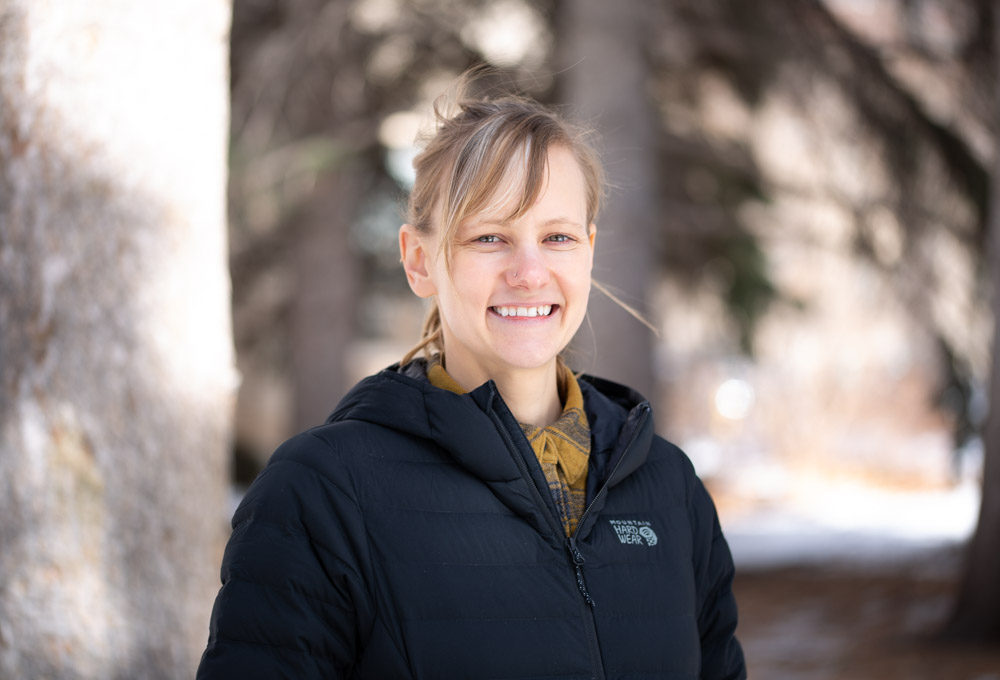 Dr. Francis is a new Assistant Professor at Colorado State University in the Department of Forest and Rangeland Stewardship. Her research is focused on understanding how forest disturbances are changing with climate change and past management. She works to develop new measurement tools to support forest management and to study the dynamics of forest composition and structure. Francis finished her PhD in Environmental Earth System Science at Stanford University in 2019. When she’s not doing science, she enjoys rock climbing. Take a look at her lab website.
Dr. Francis is a new Assistant Professor at Colorado State University in the Department of Forest and Rangeland Stewardship. Her research is focused on understanding how forest disturbances are changing with climate change and past management. She works to develop new measurement tools to support forest management and to study the dynamics of forest composition and structure. Francis finished her PhD in Environmental Earth System Science at Stanford University in 2019. When she’s not doing science, she enjoys rock climbing. Take a look at her lab website.
Q: What brought you to Forest and Rangeland Stewardship and CSU?
A: Ever since I started my career, the three-pronged mission of land grant universities like CSU – research, teaching, and extension- has been compelling to me. The times in my career when I’m the most energized and fulfilled by my work are when I’m concurrently engaged in research, building relationships with communities and land managers who are connected to the ecosystems I am researching, and teaching to prepare students for careers in natural resources. Finally, much of my research and outreach has focused on supporting the management of coniferous forest ecosystems in the western US, with one of my main current projects focused on wildfires in the upper Rio Grande watershed in northern New Mexico and southern Colorado. CSU, a land grant university in the southern Rocky Mountains, and the community of researchers, students, and staff in the Department of Forest and Rangeland Stewardship who are working to take care of forests and rangelands in a changing climate feel like home to me!
Q: What are your research and teaching interests and how did you get interested in those topics?
A: My research and teaching at CSU are focused on biometry – how to take measurements of ecosystems and analyze those measurements to produce knowledge that will inform science and management. I started my career in forest ecology, using measurements from forest inventory plots to estimate tree growth and mortality, and how they varied among different tree species. I was fascinated by what I was able to learn from detailed plot measurements, and also very curious about the millions of trees that were not located in the plots, which led me to pursue research using remote sensing – specifically, measurements from satellites and airplanes. Remote sensing enables measurements that cover entire forests with millions of trees, but I found that those measurements were not as ecologically detailed as the ones taken in the field. My background in using different types of measurements to study forest ecology and disturbances motivated me to develop measurement systems designed to overcome the trade-offs between field-based vs. remote sensing-derived measurements, by combining them using statistical and simulation models. My research program then uses these new measurement systems to contribute to improved understanding and management of forests undergoing disturbances including droughts, insect outbreaks, and wildfires.
My teaching program at CSU is focused on the theory, practice, and application of measurements. We will cover a range of forest measurements, including those from traditional field-based approaches, to measurements from remote sensing and other new technologies. I’m thrilled that I get to teach on a topic that I have been fascinated by for my entire career!
Q: What is a research question you are working on?
A: A question I’m currently working on is: How have fuel management activities impacted wildfire risk and wildlife habitat in northern New Mexico and southern Colorado? Forests in this region contain habitat for the threatened Mexican spotted owl. In order to implement fuel treatments that reduce the risk of high-severity wildfire in this region, fuel program managers are required to monitor the impact of fuel treatments on Mexican spotted owl habitat. We are working on developing an efficient and accurate system to measure attributes of forest structure that are important to both wildfire risk and Mexican spotted owl habitat using new technology. To ensure it meets requirements as a fuels and habitat monitoring system, we are engaging with a group of stakeholders – including both fuels managers and regional wildlife advocates– in the development process.
Q: What is your teaching philosophy?
A: My goal is to train students to become effective and qualified for a range of careers in forestry and natural resources! To this end, my approach combines a backbone of fundamental knowledge, with time in the field learning how to take measurements, and problem sets, exams, and projects that provide opportunities for students to practice and master quantitative analysis skills. I want students to understand how the fundamental knowledge is produced by carrying out the process of observation, measurement, and statistical analysis. It is often more fun to learn a challenging new skill when you can connect its application to something that matters to you, so I often include group or independent projects that allow students to apply what they are learning in the course to a problem of their choosing.
Q: What do you like/favorite part about CSU and the campus?
A: The people! Everyone I have interacted with so far has been very welcoming and kind. It’s clear that this is a community that cares a lot about its staff and students.